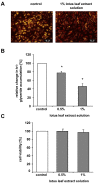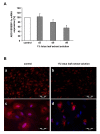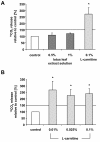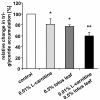Lotus leaf extract and L-carnitine influence different processes during the adipocyte life cycle
- PMID: 20687953
- PMCID: PMC2922297
- DOI: 10.1186/1743-7075-7-66
Lotus leaf extract and L-carnitine influence different processes during the adipocyte life cycle
Abstract
Background: The cellular and molecular mechanisms of adipose tissue biology have been studied extensively over the last two decades. Adipose tissue growth involves both an increase in fat cell size and the formation of mature adipocytes from precursor cells. To investigate how natural substances influence these two processes, we examined the effects of lotus leaf extract (Nelumbo nucifera-extract solution obtained from Silab, France) and L-carnitine on human preadipocytes and adipocytes.
Methods: For our in vitro studies, we used a lotus leaf extract solution alone or in combination with L-carnitine. Utilizing cultured human preadipocytes, we investigated lotus leaf extract solution-induced inhibition of triglyceride incorporation during adipogenesis and possible effects on cell viability. Studies on human adipocytes were performed aiming to elucidate the efficacy of lotus leaf extract solution to stimulate lipolytic activity. To further characterize lotus leaf extract solution-mediated effects, we determined the expression of the transcription factor adipocyte determination and differentiation factor 1 (ADD1/SREBP-1c) on the RNA- and protein level utilizing qRT-PCR and immunofluorescence analysis. Additionally, the effect of L-carnitine on beta-oxidation was analyzed using human preadipocytes and mature adipocytes. Finally, we investigated additive effects of a combination of lotus leaf extract solution and L-carnitine on triglyceride accumulation during preadipocyte/adipocyte differentiation.
Results: Our data showed that incubation of preadipocytes with lotus leaf extract solution significantly decreased triglyceride accumulation during adipogenesis without affecting cell viability. Compared to controls, adipocytes incubated with lotus leaf extract solution exhibited a significant increase in lipolysis-activity. Moreover, cell populations cultivated in the presence of lotus leaf extract solution showed a decrease in adipocyte differentiation capacity as indicated by a decrease in the ADD1/SREBP-1c signal. Importantly, our results demonstrated that a combination of lotus leaf extract solution and L-carnitine reduced triglyceride accumulation to a greater extent compared to incubation with either substance alone.
Conclusions: Overall, our data demonstrate that a combination of lotus leaf extract and L-carnitine reduced triglyceride accumulation in human (pre)adipocytes by affecting different processes during the adipocyte life cycle. For this reason, this combination might represent a treatment option for obesity-related diseases.
Figures





Similar articles
-
White Tea extract induces lipolytic activity and inhibits adipogenesis in human subcutaneous (pre)-adipocytes.Nutr Metab (Lond). 2009 May 1;6:20. doi: 10.1186/1743-7075-6-20. Nutr Metab (Lond). 2009. PMID: 19409077 Free PMC article.
-
Ethanol extract of lotus (Nelumbo nucifera) root exhibits an anti-adipogenic effect in human pre-adipocytes and anti-obesity and anti-oxidant effects in rats fed a high-fat diet.Nutr Res. 2014 Mar;34(3):258-67. doi: 10.1016/j.nutres.2014.01.003. Epub 2014 Jan 21. Nutr Res. 2014. PMID: 24655493
-
Functional antagonism between inhibitor of DNA binding (Id) and adipocyte determination and differentiation factor 1/sterol regulatory element-binding protein-1c (ADD1/SREBP-1c) trans-factors for the regulation of fatty acid synthase promoter in adipocytes.Biochem J. 1999 Dec 15;344 Pt 3(Pt 3):873-80. Biochem J. 1999. PMID: 10585876 Free PMC article.
-
Phytochemicals and regulation of the adipocyte life cycle.J Nutr Biochem. 2008 Nov;19(11):717-26. doi: 10.1016/j.jnutbio.2007.12.007. Epub 2008 May 20. J Nutr Biochem. 2008. PMID: 18495457 Review.
-
A critical review on robust self-cleaning properties of lotus leaf.Soft Matter. 2023 Feb 8;19(6):1058-1075. doi: 10.1039/d2sm01521h. Soft Matter. 2023. PMID: 36637093 Review.
Cited by
-
Alcoholic Extract of Lotus Leaves Improves Lipid Profile in Rats with HIV Protease Inhibitor-induced Dyslipidaemia.West Indian Med J. 2015 Jun;64(3):195-200. doi: 10.7727/wimj.2014.373. Epub 2015 Jul 21. West Indian Med J. 2015. PMID: 26426169 Free PMC article.
-
Propionyl-L-carnitine corrects metabolic and cardiovascular alterations in diet-induced obese mice and improves liver respiratory chain activity.PLoS One. 2012;7(3):e34268. doi: 10.1371/journal.pone.0034268. Epub 2012 Mar 23. PLoS One. 2012. PMID: 22457831 Free PMC article.
-
Plant natural products as an anti-lipid droplets accumulation agent.J Nat Med. 2014 Apr;68(2):253-66. doi: 10.1007/s11418-014-0822-3. Epub 2014 Feb 19. J Nat Med. 2014. PMID: 24550097 Free PMC article. Review.
-
Nuciferine Inhibited the Differentiation and Lipid Accumulation of 3T3-L1 Preadipocytes by Regulating the Expression of Lipogenic Genes and Adipokines.Front Pharmacol. 2021 Mar 22;12:632236. doi: 10.3389/fphar.2021.632236. eCollection 2021. Front Pharmacol. 2021. PMID: 33841152 Free PMC article.
-
Effects of potato and lotus leaf extract intake on body composition and blood lipid concentration.J Exerc Nutrition Biochem. 2015 Mar;19(1):25-30. doi: 10.5717/jenb.2015.19.1.25. Epub 2015 Mar 31. J Exerc Nutrition Biochem. 2015. PMID: 25960952 Free PMC article.
References
LinkOut - more resources
Full Text Sources
Other Literature Sources

